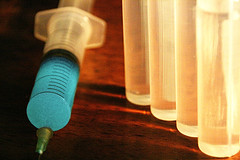 RSS FEED
RSS FEED
Archive for the ‘Medicine’ Category
My Migraine Story
May 30th, 2008

What’s your Migraine story? We all have one (all of us with Migraine disease, anyway). Having a sensitive nervous system sets us apart from the majority of people around us, and we all go through a process of realizing or coming to terms with that. With what it means to us and with how it impacts us. That process and story have become clearer to me as I have entered the on-line Migraine community, in this curious role of migraine blogger.
I have worked as a coach for many years now, helping people set goals, make choices, and live powerful lives, both in personal and business contexts. In the course of that work I have had to make many accommodations to my Migraine disease, my chronic fatigue syndrome, and my recurrent sinusitis (to name the major culprits). I have had the privilege of helping a number of other people with chronic conditions figure out how to structure their lives, businesses and careers so they can live fully despite their illnesses. The moment of truth for me came when I realized, about 7 months ago, that my chronic illnesses are not just an impediment in my life. They are an opportunity to share my professional tools and skills, and the wisdom I have accumulated, to help others manage their lives with Migraine. I was already doing it, but I had one of those moments where perception shifts, and I saw that this could be a major focus for me. Call it an epiphany, an aha, or a moment of madness, but here I am.
In my own journey it’s not a bad thing to be looking at my life through the lens of Migraine disease. I am not interested in having that be all that defines me, but it is dangerous to ignore it. I have questioned a lot
how my life might have been different without this condition. I approach this question now after nearly a half-century of life.
I’ve had migraines since at least my teens. I don’t remember the first, but at 17 after
surgery at Montefiore Hospital in the Bronx (that’s another story), leaving the hospital we drove past the Montefiore Headache Center and I thought “Wow, someone actually treats headaches? Someday, maybe soon, I’ll have to go there.” So I’m guessing I had migraines before 17. Certainly, the first few I remember clearly, in my mid-twenties, I was already calling them migraines. I could distinguish the headaches with nausea, vomiting, and nearly unbearable sensitivity to light and sound, from the regular, run of the mill headaches.
In retrospect, migraines have had a big impact on my life and my choices, even though they didn’t become frequent for me until my early forties. The biggest impact in my earlier years was on my career. I
completed law school and went to work at a big Wall Street firm. Everyone who knew me was surprised by that choice, but for me it was important to prove I could succeed in a high prestige, high pressure
world. I proved it for two years and left. In the meantime I had some doozies – vomiting in the gutter in NYC became a familiar shame in my life. I would have told you at the time that my migraines were triggered by stress. But in retrospect, those moments of high stress came with sleep disturbances (pulling all-nighters to get a brief finished or prep for court), excess caffeine, and the poor eating that went along with them. I went into the less pressured environment of a legal services office, and migraines became less frequent, until after my first child was born. Then I had the new pressure of juggling baby and child care, parenthood, chronic lack of sleep, with part-time legal work. Oh, and let me tell you about part-time legal
work. Part time in the law is like 80+ hours this week and none for the next 2 weeks, not like “I’ll work Monday, Wednesday and Friday when I have child care!” A set up for stress, exhaustion, a frantic life. By our mid-thirties we had two kids, a house, a yard, a mortgage, and one of us (me) got sick a lot.
I left the practice of law a decade ago and began doing work that I could structure in a way that worked in my life. Writing and coaching. Doing that work while making sure that I slept enough, ate right, used meditation as a regular practice. I made those career and lifestyle changes just in time to develop anaphylactic allergies to pain-killers; just in time to have a sudden increase in my migraine frequency from a few a year to a few a week. 
To tell you the whole story would require a book. I’ll let you know when I’ve gotten it written. The main thing I am looking at today is who I am – as a migraineur, yes, and as me, who is much more than just this disease. I have always thought of myself as tough. You can laugh if you want. Yes, I’m rather small and soft, not particularly athletic, and I’m not a mean person (though I can be sarcastic). There’s a mental toughness, though, a determination to keep going, to build, to create. And on the other side of that, I have to accept my delicacy. We are sensitive, we migraineurs. Sensitive to our environments. Vulnerable to odd things that don’t bother other people. I can’t seem to change the fact that I get sick a lot.
For a working symbol, I’m going to use my Iris. They are profoundly rich and beautiful. They do bruise and wilt easily. They need to be fed, watered and cared for. But they keep coming back, and growing, taking more ground. They are a connection to the splendor of life.
What’s your Migraine story?
– Megan
Tags: chronic fatigue syndrome, chronic illness, life coaching, lifestyle, Migraine disease
Posted in Medicine, Musings | Comments (2)
The Weather Report inside my head (Sinus and Migraine locked in competition)
March 16th, 2008
Sniffly with a chance of coughing? Yesterday’s migraine has transitioned into today’s sinus infection. You don’t really want to hear about the nasty greenish glop going down the back of my throat! I seem to have  two major weather systems duking it out in here.
two major weather systems duking it out in here.
I’m going to try to make sense here, but the brain is not quite up to par today, so no promises. It’s hard to think with stuff pressing on the brain – whether that’s from the inflamed blood vessels of a migraine or from blocked up sinus cavities.
I’ve been wondering for some time about the sinus/migraine connection. In a thought-provoking article, Sinuses giving you a headache? It’s probably Migraine! Teri Robert tells us that ” nearly 9 in 10 people with sinus headache symptoms likely are suffering from Migraines,” and Migraine not only causes pain in the sinus area, but can lead to nasal congestion as well! According to a research study presented in 2004 at the 46th Annual Scientific Meeting of the American Headache Society (AHS), “real” sinus headache is only present when there is a sinus infection, which typically involves fever, lots of green or yellow mucus, and swollen lymph nodes.I have to say, as one who has clear and obvious Migraines, (pounding pain in one or both temples, with extreme light and sound sensitivity) and clear and obvious sinus infections (with the green glop of doom, swollen glands and fever), the study raises as many questions as it answers. To quote Teri Robert further:
Ironically, researchers believe a few of the people in the study may have acquired sinus infections as a result of having a Migraine. Lengthy Migraine attacks can lead to swollen nasal membranes and closed off sinus passages, creating the perfect environment for an infection, said Dr. Eross.
I had one neurologist (not a headache specialist) tell me my sinus problems are probably Migraine. Without asking any further questions about my history, it sounds like he read the research, but I don’t think he was giving me useful information. I don’t generally have those suspect sinus “headaches,” I have months of recurrent infection symptoms.
This is the essential chicken and egg dilemma. Do my Migraines lead to sinus infections? Does the pressure and swelling of infection trigger Migraines? Both look likely from my own history. My internist is intrigued by the question but has no answer for me. I’ve got my hopes pinned on the headache specialist appointment in June. What difference does it make? If I can work out a good preventive regimen for either ailment, I’d love to have it help both!
appointment in June. What difference does it make? If I can work out a good preventive regimen for either ailment, I’d love to have it help both!
In the meantime, I try to live in the way that will best take care of both the sinuses and the Migraine brain, which for me involves avoiding dairy, keeping my supplements up (including magnesium and B for the head and C and zinc for the immune system), eating in a way that takes care of my gut (high fiber, not a lot of processed foods, using a pro-biotic supplement), keeping my nasal passages moist with a neti pot and saline spray, and using relaxation to keep the ole brain calm cool and collected (more or less).
Megan Oltman
Free my Brain from Migraine Pain, Free my Head from Sinus Dread?
Vitamin photo courtesy of DRB62/Daniel R. Blume
Gargoyle photo courtesy of ClatieK/Katie Claypoole
Tags: American Headache Society, migraine, sinus infection, Teri Robert
Posted in Communicating, Managing, Medicine | Comments (1)
Please support help for our heads!
March 13th, 2008
Here is the text of a letter sent Tuesday of this week to all of us on the AHDA (Alliance for Headache Disorders Advocacy) mailing list. The time is now to contact your congressperson and urge him/her to support more research funding for headache disorders. The ADHA link below makes it very easy to do. Please help NOW.
Dear AHDA advocates –
Well, the key moment has arrived for you to contact your Member of the US House of Representatives to take action for increasing NIH research for headache disorders.
A Dear Colleague letter was sent yesterday by Representatives Peter Welch and James Moran to all House offices, urging all Members of the House to co-sign a letter to Representatives David Obey and James Walsh. The Obey/Walsh letter requests inclusion of language that supports headache research to be appended to the FY09 appropriations bill for NIH. (For details, see the letter and attachments at the AHDA site.)
The more Representatives that co-sign the Obey/Walsh letter, the greater are the chances that the language will be included. The Obey/Walsh letter must be submitted with signatures by 3/19. This unfortunate deadline was a late-breaking surprise for us, so we have little more than a week to get as many signatures as possible. Please go to the AHDA website as soon as possible to contact your Representative and urge her/him to co-sign the Obey/Walsh letter now.
Blessings upon your heads!
– Megan Oltman
Tags: Alliance for Headache Disorders Advocacy
Posted in Current Affairs, Medicine, Science | Comments (2)
Botox for Migraine Treatment – News?
March 10th, 2008
In today’s London Daily Mail, reporter
The FDA is not advising doctors to stop prescribing the drug, but
they are conducting a safety review and say the reactions may be due to
overdosing. However, they are warning patients that they should receive
immediate medical attention if they have worsening or unexpected
difficulty in swallowing or talking, trouble breathing or muscle
weakness following any injection of Botox.
The dangers appear to be acknowledged in the Botox labeling. Migraine Blog reported on February 8, 2008, that:
The Warnings sections of the labeling for both botulinum toxin products
note that important systemic adverse effects, including severe
difficulty swallowing and difficulty breathing have occurred in
patients with neuromuscular disorders after local injection of typical
doses of botulinum toxin. FDA now has evidence that similar,
potentially life-threatening systemic toxicity from the use of
botulinum toxin products can also result after local injection in
patients with other underlying conditions such as those with cerebral
palsy associated limb spasticity. Systemic toxicity has been reported
in children, several of whom required feeding tubes and/or ventilation
(breathing) support.
Migraineurs please read the research, and follow up with your doctor if you have any concerns.
– Megan Oltman
hypodermic image courtesy of happysnappr/Adrian Clark
Tags: Botox, Migraine treatment, US FDA
Posted in Medicine | Comments (2)
Take at first sign of Migraine
March 5th, 2008
If you are among those lucky enough to be able to use drugs in the triptan class, Migraine abortives, you’ve seen this advice “Take at first sign of Migraine.” Most of us find them quite effective when we  follow this advice. But like many things in real life, following the advice isn’t easy.
follow this advice. But like many things in real life, following the advice isn’t easy.
Triptans were the first, and are so far the only, class of drugs specifically designed to abort a Migraine attack. When they were first introduced in the 1990’s, they revolutionized the treatment of Migraines. Rather than simply treating pain, or reducing the inflamation of blood vessels, they work directly to end the neurological process which is Migraine.
As described by Dr. Gary L’Europa in his excellent article last June in the Providence (RI) Journal, Stop Limiting Migraine Medicine , the migraine process includes these phases:
“Prodrome consists of fatigue, neck pain, hunger, thirst, and other physical symptoms that occur up to 24 hours before the headache.
“Aura occurs up to 60 minutes before the headache and produces a sensation of seeing sparkling lights or feeling numbness or tingling in the face and hand.
“Headache, lasting as long as 72 hours, consists of severe throbbing pain similar to that associated with meningitis. This pain is often associated with nausea, vomiting, light and sound sensitivity.
“Postdrome consists of fatigue, neck pain and lethargy that lasts 24 to 48 hours after the headache.”
So what’s the first sign of Migraine? Most migraineurs report that triptans are not particularly effective in the prodrome phase; they wait to take them at the first sign of headache. I can attest to the fact that my triptans are most effective if taken at the very first sign of head pain. I haven’t tried them in prodrome, since fatigue, neck pain, hunger, thirst (and irritability) can have other causes. Also because I am afraid to waste one of my precious triptans. Which brings us to my main point.
Triptans tend to be very expensive. Imitrex, which I take, retails at around $20 to $30 per pill. It often takes two doses to end a Migraine attack. Given the cost of triptans, many insurance companies began in 2007 to set lower limits on the number of doses per month they would cover. My coverage  went from 9 per month to 4. This was based on some math they had done on what the “average” migraineur needed. I guess I can take pride in being, once again, “above average!” I have 4 – 5 migraine attacks per month. Migraine researchers estimate that 46% of migraineurs have more than 3 attacks per month. Do they limit the doses of insulin a diabetic can have to the amount an “average” diabetic would need? (Maybe they do… someone fill me in… either way, it’s a scandal!) Seems to me the reason our doctors prescribe for us, not our insurance companies, is because they treat the actual patient, not the average patient!
went from 9 per month to 4. This was based on some math they had done on what the “average” migraineur needed. I guess I can take pride in being, once again, “above average!” I have 4 – 5 migraine attacks per month. Migraine researchers estimate that 46% of migraineurs have more than 3 attacks per month. Do they limit the doses of insulin a diabetic can have to the amount an “average” diabetic would need? (Maybe they do… someone fill me in… either way, it’s a scandal!) Seems to me the reason our doctors prescribe for us, not our insurance companies, is because they treat the actual patient, not the average patient!
My insurance company politely suggests I look at having another triptan prescribed for me, as Imitrex is one of the most expensive. I’d be happy to, but becasue of my multiple drug allergies, the neurologist I saw recently wasn’t willing to prescribe a different one at this point.
As Teri Robert pointed out in her article Doctor speaks out about insurance limiting triptan Migraine medications,
“Limiting triptans is beyond absurd. It’s counter productive, inane, and cruel. Many Migraineurs, when faced with a Migraine and no triptans, end up in the emergency room. Ever pay an emergency room bill? The cost of a reasonable month’s supply of triptans costs far less than a single ER visit. Duh! Maybe part of the problem is that many insurance plans have two parts — medical care and prescription coverage. The people managing the prescription coverage don’t care about ER payments because that’s a different budget.”
After many calls, 4 months, over $350 out of my pocket for medication (and several seemingly stress triggered Migraine attacks following calls to the insurance company,) they have now told me they will cover 9 pills per 23 days. This comes out to almost 12 doses per month. Which ought to be enough for my average month, but…
Can I take the Imitrex at the first sign of Migraine? Certainly not. I have moments, or sometimes hours, of mild migraine pain up to 8 times per month. That’s on top of my 4 – 5 “full blown” migraines. This may be the sign of a transforming migraine pattern. I have an appointment with a bona fide migraine specialist in early June – we’ll have to talk on this blog about the lack of qualified headache specialists another time. For now, my attitude seems to be that the pain isn’t bad – many of you have it worse – so I save the Imitrex for when I feel a “real one” coming on.
 Is this a good strategy? Probably not. My other alternative, I suppose is to pay out of pocket for additional Imitrex (at $26 per pill at my local pharmacy.) I do get what samples my doctor can spare me when I see him. But I have to say, when it comes to aborting Migraine, most of us are between a rock and a hard place.
Is this a good strategy? Probably not. My other alternative, I suppose is to pay out of pocket for additional Imitrex (at $26 per pill at my local pharmacy.) I do get what samples my doctor can spare me when I see him. But I have to say, when it comes to aborting Migraine, most of us are between a rock and a hard place.
– Megan Oltman
It’s a paradox wrapped in an enigma!
Signs of Spring photo courtesy of Just-Us-3
Hammer photo courtesy of Darren Hester
Tags: Migraine abortive medication, sumatriptan, triptans
Posted in Managing, Medicine, Rant | Comments (5)
“Breaking the Headache Cycle”
February 18th, 2008
Breaking the Headache Cycle by Ian Livingstone, M.D. and Donna Novak, R.N.
When my migraine pattern suddenly shifted from once month or less to three to four times per week, I  went to see Dr. Livingstone. When I first saw him in August of 2004, it was six months after I had two episodes of anaphylactic shock, caused by ibuprofen. I was a little gun-shy of trying new medications. I did agree to try Imitrex – I needed to be able to abort my attacks. But instead of preventive medications, Dr. Livingstone suggested that I get into a regular relaxation routine – using deep breathing, meditation and
went to see Dr. Livingstone. When I first saw him in August of 2004, it was six months after I had two episodes of anaphylactic shock, caused by ibuprofen. I was a little gun-shy of trying new medications. I did agree to try Imitrex – I needed to be able to abort my attacks. But instead of preventive medications, Dr. Livingstone suggested that I get into a regular relaxation routine – using deep breathing, meditation and
guided imagery to strengthen my nervous system’s relaxation response.
I first read the book at that time: Breaking the Headache Cycle: A Proven Program for Treating and Preventing Recurring Headaches. I took on practicing meditation daily, and after about six months I found my migraines reduced to 2 or 3 per month. The methods outlined in the book were very effective for me, in combination with the migraine abortive, to reduce my migraines to a manageable level.
The authors say migraineurs’ nervous systems are “very reactive to any change, even good change. This
sensitivity is the hallmark of the migraine condition. Unless it is understood and recognized, the migraine disorder cannot be adequately treated.”
If our nervous systems are over-responsive, it makes sense that relaxation and meditation will calm down the responsiveness of the nervous system. Dr. Livingstone cites studies showing that preventive medications reduce migraine about 40% on average (the book was published in 2003 – there may be more up to date statistics on this); and other studies showing that a regular relaxation practice reduces migraines 40% on average. Is it a safe bet to say if doing both, we might reduce migraine 80%? That’s a number I could be very happy with!
down the responsiveness of the nervous system. Dr. Livingstone cites studies showing that preventive medications reduce migraine about 40% on average (the book was published in 2003 – there may be more up to date statistics on this); and other studies showing that a regular relaxation practice reduces migraines 40% on average. Is it a safe bet to say if doing both, we might reduce migraine 80%? That’s a number I could be very happy with!
Many times I pause and do deep breathing when I first feel pain in my head, or even just when I feel my tension mount. This often down-shifts me from a budding migraine back to a state of no head pain. I have come to be able to notice when I am getting too excited or too engaged – it’s not just negative 
stress that can trigger me! Not surprisingly, when I got out of the habit of practicing regular relaxation, my migraines increased again. As tricky as
it is to remember to take a variety of medications, in the right amounts, at
the right times, I think it is even more challenging to establish and keep a
routine of putting the busy concerns of life aside and take time out to look
inward, breathe deep, become aware of the body, calm oneself, and relax.
I came to these methods already convinced – I was not a stranger to yoga, meditation and relaxation. I had practiced yoga in many periods in my life, starting in my teens, and meditation and guided imagery from my early twenties. Later, as a life and business coach, I have used meditation and guided imagery with my clients to help them get clear about issues that were stopping them, and to visualize what they wanted in their lives. So I wasn’t surprised that this practice would aid with migraine disease as well. The challenge is
keeping it in my life as all the demands of life crowd in. The reward is getting to know my own system
really well, and gaining at least a little bit of control over it.
By the way, I think preventive medication is a great thing, and many migraineurs find a lot of success with it. I may be headed down that path myself, as my migraine pattern has changed and my treatment will need to change too. But I’ll always keep relaxation as part of my routine. It makes me feel good!
– Megan Oltman
Nothing to gain from pain!
Tags: Breaking the Headache Cycle, Ian Livingstone MD, Migraine attack, Migraine preventive medication, reactive nervous system, relaxation practice
Posted in Books, Managing, Medicine, Tips & Techniques | Comments (2)
Vitamin Therapy for Migraine Prevention
February 15th, 2008
This is not News in the capital N sense but news in my life. I had my first neurologist consult in 4 years today, since Dr. Livingstone moved to Arizona. I am, like many of us, a complicated case. In my case the complications include my anaphylactic allergies to (apparently) most NSAIDs (non-steroidal anti-inflammatories, a.k.a. most OTC pain meds and quite a few prescription ones). My new doctor wants to go very slowly in adding medications because of these allergies, and the fact that I tend to get a lot of medication side-effects. So for the moment he added another form of Imitrex as an abortive (now I will be able to give myself injections, oh lovely) and prescribed vitamin therapy for prevention.
today, since Dr. Livingstone moved to Arizona. I am, like many of us, a complicated case. In my case the complications include my anaphylactic allergies to (apparently) most NSAIDs (non-steroidal anti-inflammatories, a.k.a. most OTC pain meds and quite a few prescription ones). My new doctor wants to go very slowly in adding medications because of these allergies, and the fact that I tend to get a lot of medication side-effects. So for the moment he added another form of Imitrex as an abortive (now I will be able to give myself injections, oh lovely) and prescribed vitamin therapy for prevention.
In a startling piece of non-news, I am sensitive to medications. He shrugged – “sure you’re sensitive – you get migraines.” This vicious circle is familiar to most migraineurs. Sensitive nervous system – gets migraines. Sensitive nervous system – gets side effects. Sensitive immune system (I guess) – develops medication allergies. So for the next three months, I am to try 400 mg per day of magnesium and 200 mg per day of B2 (riboflavin).
I am certainly in favor of using nutritional means to deal with illness. That fits with my holistic philosophies on life! So I am crossing my fingers. I know a number of people who have had success with magnesium, though many of them take preventive medications as well. I have to admit I’m not 100% happy, though. My recent increase in migraine frequency is taking its toll on my life. I guess I’m ready to be a bit  more aggressive about my treatment. So we shall see… my new doctor search may not be over.
more aggressive about my treatment. So we shall see… my new doctor search may not be over.
Read more about magnesium for migraines in The Magnesium Solution for Migraine Headaches. Let me know what you think!
– Megan
So many pills, so little time!
newspaper image courtesy of Matt Callow
Tags: magnesium, migraine prevention, vitamin therapy
Posted in Books, Managing, Medicine | Comments (0)
This is snot about migraine…
February 9th, 2008
Okay, I just had to share this. I’m up past my bed time, getting punchy. In the continuing quest for relief from my recurrent sinus infections we are considering whether surgery to remove nasal polyps might be helpful. Apparently there is a frequent correlation between seasonal allergies or asthma (I’ve got the allergies, not the asthma), aspirin allergy (which I have) and nasal polyps. My doctor wants me to research this connection, known as Samter’s Triad.
So I’m on pubmed.gov reading these medical studies all written in medical jargon and all very serious… So here’s one about “Medical and surgical considerations in patients with Samter’s triad” and they’re going on about doing “functional endoscopic sinus surgery (FESS)” and then the patients were CT scanned and they measured the FESS results by a test called (I kid you not) the “Sino-Nasal Outcome Test (SNOT-20).”
So if I go through with this – you can ask me “hey, how’d your SNOT test come out?” “We were hoping for a better outcome – but all we got was the same old SNOT…”
Who said doctors have no sense of humor?
– Megan
Gotta laugh, otherwise we’d cry.
Tags: endoscopic sinus surgery, nasal polyps, Samter's Triad, sinus infection
Posted in Medicine, Silliness | Comments (0)
That disclaimer thing...
Remember: nothing we do here is medical advice or treatment or is a substitute for medical advice or treatment. Get competent medical advice to learn more about your migraines, possible treatments and risks.
What's New on Migraine Support Group Coaching |
Recent Comments
- on Calling all Redheaded Migraineurs
- on No, You’re not Crazy, You just Have Migraines
- on No, You’re not Crazy, You just Have Migraines
